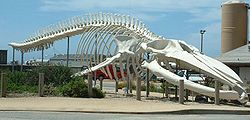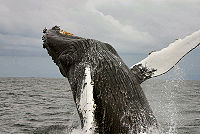Portal:Cetaceans/Selected Picture/Archive
These are all of the pictures previously selected for showing on the Cetaceans Portal main page.
June, 2006[edit]

A bottlenose dolphin surfs the wake of a research boat on the Banana River - near the Kennedy Space Center
The Bottlenose Dolphin (Tursiops truncatus) is the most common and well-known dolphin species. It inhabits warm and temperate seas worldwide and may be found in all but the Arctic and the Antarctic Oceans.
July, 2006[edit]
Spyhopping is the act of coming out of the water vertically and momentarily staying out of the water in a manner akin to a human treading water. A powerful individual can spyhop as much as half of its body out of the water. The reasons for spyhopping are likely to be similar to those of breaching. Further spyhops may well be used so that the whale can examine its surroundings above the surface — for instance to look at boats. For this a spyhop may be more useful than a breach, because the view is held steady for a longer period of time.
August, 2006[edit]

The Dusky Dolphin (Lagenorhynchus obscurus) is a highly gregarious and acrobatic dolphin found in coastal waters in the Southern Hemisphere. It was first identified by John Gray in 1828. It is very closely genetically related to the Pacific White-sided Dolphin, although current scientific consenus is that they are distinct species.
September, 2006[edit]

The Humpback Whale (Megaptera novaeangliae) is a mammal which belongs to the baleen whale suborder. It is a large whale: an adult usually ranges between 12–16 m (40–50 ft) long and weighs approximately 36,000 kilograms (79,000 lb). It is well known for its breaching (leaping out of the water), its unusually long front fins, and its complex whale song. The Humpback Whale lives in oceans and seas around the world, and is regularly sought out by whale-watchers.
October, 2006[edit]
The Bottlenose Dolphin (Tursiops truncatus) is the most common and well-known dolphin species. It inhabits warm and temperate seas worldwide and may be found in all but the Arctic and the Antarctic Oceans. Bottlenose Dolphins are grey, varying from dark grey at the top near the dorsal fin to very light grey and almost white at the underside. The salt water makes them hard to see both from above and below when swimming. The elongated upper and lower jaws give the animals their name of bottlenose. The real nose however is the blowhole on top of the head, and the nasal septum is visible when the blowhole is open. Their face shows a characteristic "smile".
November, 2006[edit]

A U.S. Navy Marine Mammal Program bottlenose dolphin named K-Dog wearing a locating pinger, performed mine clearance work in the Persian Gulf during the Iraq War.
The United States and Russian militaries have trained and employed dolphins for several reasons. Such military dolphins can be trained to rescue lost divers or to locate underwater mines. Military dolphins were used during the First and Second Gulf War.
December, 2006[edit]

A Blue whale skeleton, outside the Long Marine Laboratory at the University of California, Santa Cruz.
Blue Whales are the largest animal ever to have existed. Hunting of Blue Whales has led to a severe decline in numbers across the globe.
January, 2007[edit]
The baleen whales form the Mysticeti, one of two suborders of the Cetacea. Baleen whales are characterized by having baleen plates for filtering food from water, rather than having teeth. This distinguishes them from the other suborder of cetaceans, the toothed whales (Odontoceti). Living Mysticeti species have teeth only during the embryonal phase. Fossil Mysticeti had teeth before baleen evolved. Baleen whales are generally larger than toothed whales, and females are larger than males. This group comprises the largest living animal species, the Blue Whale. Baleen whales have two blowholes, causing a V-shaped blow.
February, 2007[edit]
Whaling in Norway is a centuries long tradition in Northern Norway. Only Minke whaling is permitted, from a population of 110,000 animals in the North east Atlantic and is argued by proponents and government officials to be sustainable.
More on Whaling in Norway
March, 2007[edit]

Humpback Whales blow a curtain of bubbles around their prey and then lunge through them with their mouths open. The Humpbacks strain the tiny creatures, called krill, through the baleen in their mouths.
More on lunge-feeding
April, 2007[edit]

The Fin Whale, at 27 metres long, is the second largest whale and animal after the Blue Whale. It is found in all the world's major oceans, and in waters ranging from the polar to the tropical. It is absent only from waters close to the ice pack at both the north and south poles and relatively small areas of water away from the large oceans.
More on Fin Whales
May, 2007[edit]

The Harbour Porpoise (Phocoena phocoena) is one of six species of porpoise. It is one of the smallest ocean mammals in the sea. As its name implies, it stays close to coastal areas or river estuaries and as such is the most familiar porpoise to whale watchers. This porpoise often ventures up rivers and has been seen hundreds of miles from the sea.
More on the Harbour Porpoise
June, 2007[edit]

Baleen makes up baleen plates, which are arranged in two parallel rows that look like combs of thick hair; they are attached to the upper jaws of baleen whales. It is composed of keratin, which is the same substance that makes up human hair and nails. Whales use these combs for filter feeding. Whales are the only vertebrate group to use this method of feeding in great abundance (flamingos and crabeater seals use similar methods, but do not have baleen), and it has allowed them to grow to immense sizes. The Blue Whale, the largest animal ever to live, is a baleen whale.
More on baleen
July, 2007[edit]

Many whales are known to breach the waters surface. The act of leaping generates more power than any other act performed by a non-human animal.
Some whales, such as Sperm Whales, perform a breach by travelling vertically upwards from depth, and heading straight out of the water. Others, such as the Humpback Whale (pictured), travel close to the surface and parallel to it, and then jerk upwards at full speed to perform a breach. In a typical breach, as performed by a Humpback or Right Whale, the whale clears the water at an angle of about 30° to the horizontal.
More on whale behaviour
August, 2007[edit]

A dolphinarium is an aquarium for dolphins. The dolphins are usually kept in a large pool, though occasionally they may be kept in pens in the open sea, either for research or for public performances. Some dolphinariums consist of one pool where dolphins perform for the public (such as above at Loro Parque), others have expanded into much larger parks, keeping other marine animals and having other attractions.
More on dolphinariums
